Bible Devotion
Day 1
Scriptural Reflection
Exodus 25:10–22
We shall
continue the study of Exodus, the second book of the Old Testament.
As we shall be reflecting on the
building of the tabernacle and its contents, the following sketch of the layout
of the tabernacle may be helpful:
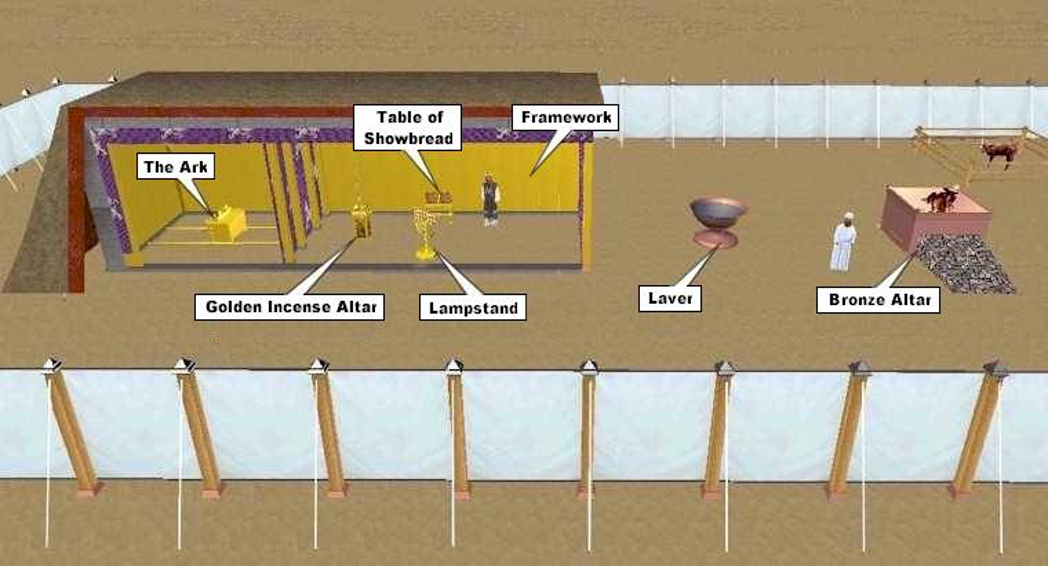
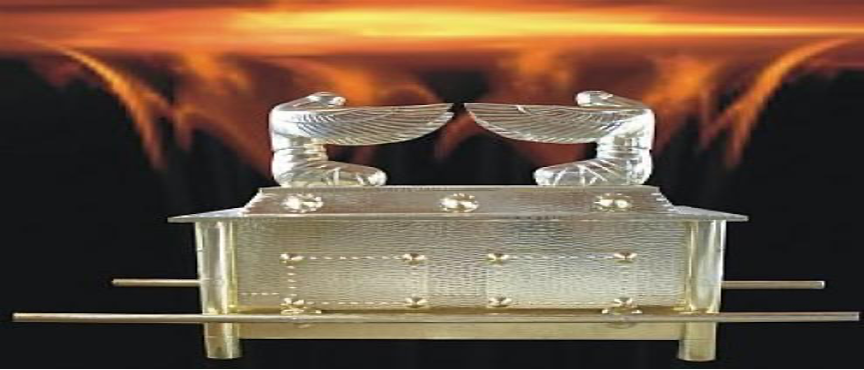
It is perhaps helpful to note that these instructions (concerning the building of the tabernacle) are addressed to Moses directly, and thus in v. 22 when God says, “I will meet with you”, "you" is singular and refers to Moses.
(1) I have selected this rare image of the ark which shows the poles being attached to the lower part of the ark (the feet) which correspond more closely to the instruction in v. 12. However, if you are viewing this image in color, it is not gold. Why does the appearance of the ark have to be in gold?
(2) Why should there be cherubim on top of the cover? Why should they be positioned in such a posture? How much does it reflect the reality of the heavenly worship?
(3) Why is the cover called the Atonement Cover? (See Leviticus 16:15-16.)
(4) Why should the two tablets of the Ten Commandments be put inside the ark?
(5) Contrast the function served by the cherubim at the end of Genesis 3 to their present function. What might be the message that is being conveyed by the ark?
(6) The Israelites have been summoned to Mount Sinai to meet with God and receive the covenant law and they would consider Mount Sinai as the Mountain of God. But with this portable ark, what is God’s message to them and to Moses (see v. 22)?
(7) When we gather our thoughts on all that are being described about the ark, what kind of a throne is being depicted by this ark? What does God expect His people to think of this ark? (See Hebrews 4:16.)
(8) What have you learned today and how may you apply it in your life?
Meditative Reflection
The Approachable God
“There, above the cover between the two cherubim that are over the ark of the covenant law, I will meet with you and give you all my commands for the Israelites.” (Exod. 25:22)
As God reveals His desire to dwell among His people and instructs Moses to build the tabernacle, the first thing He mentions is the Ark of the Covenant. The fact that everything is wrapped or made in gold, plus the presence of the two cherubim, certainly reflect the holy character of God and the fact that even angelic beings are subservient to Him and worship Him. This awesomeness is thus to be approached with utter reverence.
However, the naming of the cover as the “atonement cover” and the deposit of the Testimony (i.e. the two tablets of the Ten Commandments) signify not only a special covenantal relationship between God and His people, but the fact that even sinful men can now come into the presence of this awesome, holy God.
Of course, we now know that the “atonement cover” is pointing to the atoning sacrifice by the Son of God, Jesus Christ, whose blood “covers” all our sins and that all God’s commandments are satisfied too by His death on the cross. As a result, we who have believed in Him can come boldly before the throne of God, which is not a throne of judgment, but a throne of grace that “we may receive mercy and find grace to help us in our time of need” (Heb. 4:16).
Of course , Moses was the one who received this revelation from God concerning the tabernacle and the ark directly, and he indeed met with God in the tabernacle before the ark and received commands for the Israelites, but I suspect he had no idea that one day, we all can approach the throne of God like him—or, should I say, in a far more intimate way, as now God dwells within the heart of each of His children. If Moses knew that what he was instructed to build symbolized such an eventuality and that atonement is made possible not by the blood of animals, but by the very blood of God Himself one day, he would carry out his project with even greater excitement.
As much as we admire Moses and his special relationship with God, he had to wait until God descended upon the tabernacle to meet with him, often at God’s timing, but ours is in every way far more blessed that his. We can come to His throne of grace anytime we desire. How much should we treasure our communion with God today!
Day 2
Scriptural Reflection
Exodus 25:23–30
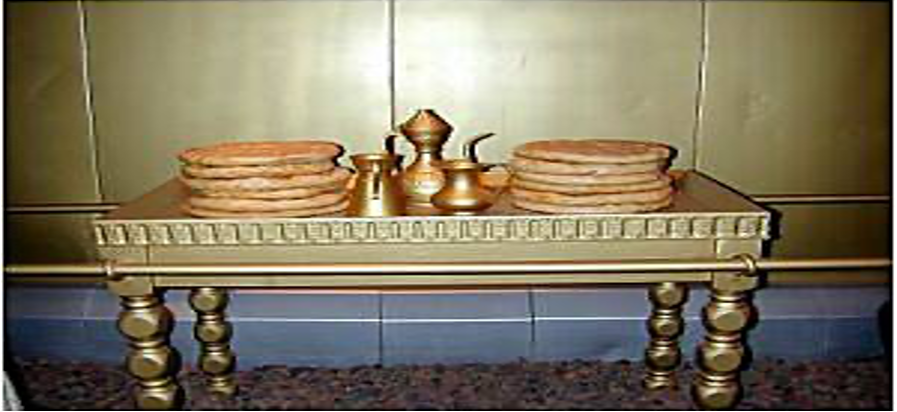
While the “origin and the
exact significance of this Presence-Bread are not clear” (Durham, 362),
let’s reflect based on what is being written and it is helpful to
consult Leviticus 24:5-9 where the function of the bread and the incense
is explained (also see Note below):
(1) The word for
“Presence” is literally “face” (Alter, 463). So what
does the “Bread of (God’s) face” mean to the people?
(2) Presumably, this special bread was placed on the table every Sabbath along with the incense which is burned to the Lord (to represent the bread according to Lev. 24:7). Although the bread from the previous week would be eaten by the priests (and the priests only—see 1 Sam. 21:4-6 and Matt. 12:4), how does the use of the Bread of Presence signify “as a lasting covenant” by the Lord (see Lev. 24:8)?
(3) What does eating normally represent in the Oriental culture?
So as God accepts the bread (symbolized by the burning of the incense) and the priests eat of the same bread a week later, what does this signify and what is the “lasting covenant” being affirmed by this weekly ritual?
(4) If the 12 loaves
of bread symbolize the eternal fellowship of God with His people, such a covenant
is still perpetuated within the most holy setting. Note the following:
a. The ritual takes place “in a holy place” as “a most holy part of their regular share of the offerings made to the Lord” (Lev. 24:9).
b. The entire table is made not only of gold, but designed in such a way that any direct human contact or handling is avoided.
How should this balance between the maintenance of holiness and fellowship speak to our communion with God today?
(5) What have you learned today and how may you apply it in your life?
Note:
The table has four kinds of containers on it:
1. A plate on which the Bread of Presence was placed
2. A small pan for incense
3. A pitcher for the wine of libation
4. A bowl into which the libation was poured
Meditative Reflection
Taking God’s Grace for Granted
“Over lay it (the table) with pure gold…and make its plates and dishes of pure gold, as well as its pitches and bowls for the pouring of offerings.” (Exod. 25:24, 29)
The use of gold for the Ark and the Table of Presence is an unmistakable symbol for the holiness of the Lord. The base material being acacia wood is a matter of practicality, for if the whole ark or table is made of pure gold it will be too heavy to carry. Both the design of the ark and the design of the table is such that when they are moved there would not be any direct contact with human hands.
While the ark itself is placed inside the Holy of Holies, which is only entered into by the High Priest once a year with the blood of sacrifice, the table is visible to the attending priests. As a result, this table and its bread stand as a visible covenant of God’s presence with His people. And as the bread is being accepted by the Lord (symbolized by the burning of the incense beside the bread), the same bread is being eaten by the priests the week after. This weekly ritual (as long as it is faithfully maintained) stands as a lasting covenant not only of God’s presence, but of His fellowship with His people. As we know, this mutual “eating” of the bread is a symbol of friendship.
All of the above has been fulfilled by our Lord Jesus, as He is the true Bread of Life (Jn. 6:51ff) on whom we are fed for eternal life, and with whom we have daily fellowship. But the Table of Presence continues to remind us of our need for holiness. If the Bread of Presence is considered the most holy of offerings (Lev. 24:9), how much more should we approach the Bread of Life in holiness. No wonder as the Corinthian believers ate the Lord’s Supper “without recognizing the body of the Lord”, many were “weak and sick and asleep” (1 Co. 11:29, 30). Therefore, as we emphasize that we are under grace, we should not overlook that our Lord remains the Holy One who cannot be taken lightly.
Day 3
Scriptural Reflection
Exodus 25:31–40
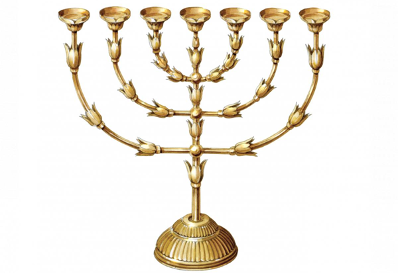
(1) As
you read about the design of the lampstand, consider these questions:
a. What catches your attention or imagination?
b. What questions does it evoke in you?
(2) On a practical level, the Holy Place needs light for the attending priests to serve before the Lord on behalf of the people and the lampstand serves this purpose. But its spiritual implication is also unmistakable. Apart from the symbol for gold, what other symbols can you think of that are represented by this golden lampstand?
(3) While within the Pentateuch, there is no immediate spiritual significance attached to it, God does reveal to Zechariah its spiritual significance (or at least one of its spiritual significances) in Zechariah 4:1-14. What is it?
(4) The Lord Jesus also uses golden lampstands as an analogy in Revelation 1:20. What do those lampstands stand for? How may we, as a result, understand the spiritual function of this golden lampstand within the tabernacle?
(5) Commentators, in general, consider the use of the almond-shape because of “the fact that it is the earliest of all the trees in both its blossom and its fruits” (K&D, 435) (Jer. 1:11, 12). If this is the case, what then is the significance of shaping the lampstand after the shape of an almond tree?
(6) What is the significance of the reiteration in v. 40?
(7) What have you learned today and how may you apply it in your life?
Meditative Reflection
The Golden Lampstand
“Consider how far you have fallen! Repent and do the things you did at first. If you do not repent, I will come to you and remove your lampstand from its place.” (Rev. 2:5)
Allow me to share with you Keil & Delitzsch’s thoughts on the significance of the golden lampstand then and now as follows:
“The signification of the seven-armed candlestick is apparent from its purpose, viz., to carry seven lamps, which were trimmed and filled with oil every morning, and lighted every evening, and were to burn throughout the night (ch. 27:20, 21; 30:7, 8; Lev. 24:3, 4). As the Israelites were to prepare spiritual food in the shew-bread in the presence of Jehovah, and to offer continually the fruit of their labour in the field of the kingdom of God, as a spiritual offering to the Lord; so also were they to present themselves continually to Jehovah in the burning lamps, as the vehicles and media of light, as a nation letting its light shine in the darkness of this world (cf. Matt. 5:14, 16; Lk. 12:35; Phil. 2:15). The oil, through which the lamps burned and shone, was, according to its peculiar virtue in imparting strength to the body and restoring vital power, a representation of the Godlike spirit, the source of all the vital power of man; whilst the oil, as offered by the congregation of Israel, and devoted to sacred purposes according to the command of God, is throughout the Scriptures a symbol of the Spirit of God, by which the congregation of God was tilled [sic] with higher light and life. By the power of this Spirit, Israel, in covenant with the Lord, was to let its light shine, the light of its knowledge of God and spiritual illumination, before all the nations of the earth. In its seven arms the stamp of the covenant relationship was impressed upon the candlestick; and the almond-blossom with which it was ornamented represented the seasonable offering of the flowers and fruits of the Spirit, the almond-tree deriving its name…from the fact that it is the earliest of all the trees in both its blossom and its fruit (cf. Jer. 1:11, 12). The symbolical character of the candlestick is clearly indicated in the Scriptures. The prophet Zechariah (ch. 4) sees a golden candlestick with seven lamps and two olive-trees, one on either side, from which the oil-vessel is supplied; and the angel who is talking with him informs him that the olive-trees are the two sons of oil, that is to say, the representatives of the kingdom and priesthood, the divinely appointed organs through which the Spirit of God was communicated to the covenant nation. And in Rev. 1:20, the seven churches, which represent the new people of God, i.e., the Christian Church, are shown to the holy seer in the form of seven candlesticks standing before the throne of God.”
(Keil & Delitzsch, 435)
Day 4
Scriptural Reflection
Exodus 26:1–37
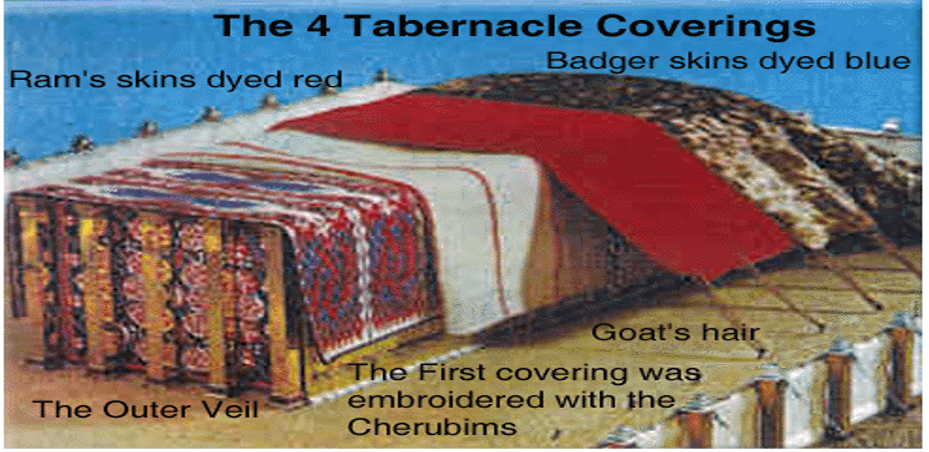
This is a long chapter that could be rather mundane, but I would suggest that you still read it slowly with the following divisions and highlights as a guide. Perhaps, pay attention to the kind of materials and colors, and try to understand their meaning:
Vv. 1-6: The tabernacle is made up of 10 curtains of expensive fabric and yarn of two sets of five curtains each, joined by loops to stretch about 60 feet in length and 42 feet in height. Note that cherubim are embroidered on them.
Vv. 7-14: To protect the expensive curtains, an additional set of curtains and two covers are to be made. The curtains are made of goat skins with hair intact, stretching about 66 feet in length and 45 feet in height, enough to cover the tabernacle proper, including its front and back. In addition to these two layers, another cover of rams’ hide, plus another cover of sea-cow’s hides are to be made, making the tabernacle a tent of four layers.
Vv.15-30: These curtains are to be held by upright supports anchored in pedestals of silver and bound together by a series of cross-members and two special corner supports.
Vv. 31-35: The tabernacle is to be further divided into a smaller Holy of Holies (of 15’ x 15’ x 15’) where the ark will be located. It is separated from the Holy Place (of dimensions 30’ x 15’ x 15’) by a veil with fine fabric with the cherubim embroidered on it.
Vv. 36-37: The open east end of the tabernacle is to be closed by a screen made of the same materials as the inner curtains and the veil.
(1) Did you notice a gradual change in the type of materials in the design of the tabernacle from more to less precious materials the greater the distance from the Holy of Holies and the Holy Place? Why is it the case?
(2) Apart from the two cherubim on top of the Ark cover, more are to be embroidered on the innermost layer of the curtains. What does this portray?
(3) It is believed that the design of the support system emphasizes its portability, meaning that the tabernacle depicts a Presence on the move. Some commentators think that it points to the temporariness of God’s presence, while some think that it is a sign of His constant presence wherever His people move. Which do you think is the case? Why?
(4) Read vv. 31-34 again about the erection of the veil separating the Holy of Holies from the Holy Place. Then read Mark 15:38. Imagine you were the priest who was on duty in the Holy Place witnessing the splitting of the veil. What impact might it have on you and others who rushed in to see what had happened?
(5) What have you learned today and how may you apply it in your life?
Meditative Reflection
Towards a Proper Understanding of the Use of Images
“Make the tabernacle with ten curtains of finely twisted linen and blue, purple and scarlet yarn with cherubim worked in them by a skilled craftsman.” (Exod. 26:1)
As we read the various instructions about the construction of the tabernacle, we might wonder why the God who is so strongly against the making of idols would use images for His sanctuary. I wish to share with you the thoughts of the 7th century Eastern Church father, John of Damascus on this matter. We may not agree with him on everything concerning the use of images and icons for today, but his points on the tabernacle are well taken:
“And the Lord spoke to Moses, saying, 'Behold I have called by name Beseleel …And I have filled him with the spirit of God, with wisdom and understanding, and knowledge in all manner of work. To devise whatsoever may be artificially made of gold, and silver, and brass, of marble and precious stones, and variety of wood.' (Exod. 31:1-5) [18] And again: 'Moses said to all the assembly of the children of Israel…Let everyone that is willing and hath a ready heart, offer them to the Lord, gold, and silver, and brass, violet, and purple, and scarlet twice dyed, and fine linen, goat's hair, and ram's skins died red and violet, colored skins, selim-wood, and oil to maintain lights and to make ointment, and most sweet incense, onyx stones, and precious stones for the adorning of the ephod and the rational…' (Exod. 35:4-10).
"See you here the glorification of matter which you make inglorious. What is more insignificant than goat’s hair or colors? Are not scarlet and purple and hyacinth colors? Now, consider the handiwork of man becoming the likeness of the cherubim. How, then, can you make the law a pretence for giving up what it orders? If you invoke it against images, you should keep the Sabbath, and practice circumcision. It is certain that 'if you observe the law, Christ will not profit you. You who are justified in the law, you [19] are fallen from grace' (Gal. 5:2-4). Israel of old did not see God, but 'we see the Lord’s glory face to face.' (2 Co. 3:18)
"We proclaim Him also by our senses on all sides, and we sanctify the noblest sense, which is that of sight. The image is a memorial, just what words are to a listening ear. What a book is to the literate, that an image is to the illiterate. The image speaks to the sight as words to the ear; it brings us understanding. Hence God ordered the ark to be made of imperishable wood, and to be gilded outside and in, and the tablets to be put in it, and the staff and the golden urn containing the manna, for a remembrance of the past and a type of the future. Who can say these were not images and far-sounding heralds? And they did not hang on the walls of the tabernacle; but in sight of all the people who looked towards them, they were brought forward for the worship and adoration of God, who made use of them. It is evident that they were not worshipped for themselves, but that the people were led through them to remember past signs, and to worship the God of wonders. They were images to serve as recollections, not divine, but leading to divine things by divine power.”
(John of Damascus, On Divine Image, 18-19)
Day 5
Scriptural Reflection
Exodus 27:1–8; 20–21
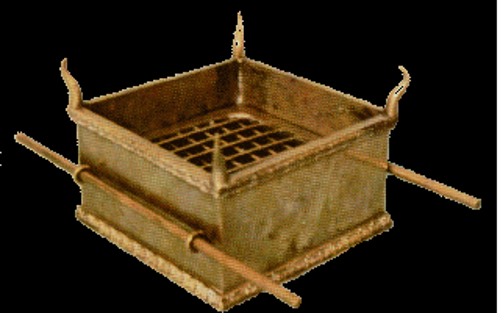
Vv. 1-8: The Altar
This is, perhaps, the most-often used furniture in the tabernacle in that sacrifices would be made daily by the priests on behalf of the people. In actual fact, without the altar, there is no access to the Presence of the Lord at all. And in the process of sacrifice, the blood of the sin-offering is to be smeared upon it (Lev. 4:7). This ritual constantly reminds the people of their sins and their need for atonement through the blood of animals.
(1) As pagan worship often took the form of sacrifice of animals on their altars as well, how should the Israelites distinguish themselves and their worship from the pagans?
(2) Look up Exodus 21:14 and I Kings 1:50-53. Do you get a sense of how the Israelites looked upon the altar?
(3) Upon their return from the exile after the destruction of the temple by the Babylonians, the first thing the Israelites did was to rebuild their altar (Ezra.3:2-6). Why was that?
(4) Ever since AD. 70, there is basically no prescribed altar to make their sacrifice. What should be the message to the Jews today?
(5) Apart from the need to come before God with the blood of sacrifice, what other meanings does the offering of sacrifice entail?
(6) Now as Christians, we do not need to perform the rites of sacrifice because Jesus, the Lamb of God has made the ultimate, once-for-all sacrifice for our sins. How then should we live out the ultimate meaning of worship through sacrifice to God? (See Rom. 12:1-2.)
Vv. 20-21: Oil for the Lampstand
The instruction to use clear oil (not pressed) is to ensure the least amount of smoke generated from the light, and apparently the task of keeping the lamps burning from evening until morning was the responsibility of the priest on the evening shift. Psalm 134:1 has this to say to the night-shift priest: “Praise the Lord, all you servants of the Lord who minister by night in the house of the Lord.”
(7) Why does the psalmist make special mention of them, who presumably have far less to do except to keep the lampstand glowing, and are far less visible to the public?
(8) What might be the lesson for you today?
Meditative Reflection
The Unique Worship of Yahweh
“Build an altar of acacia wood, three cubits high; it is to be square, five cubits long and five cubits wide.” (Exod. 27:1)
The altar has to be the most-used furniture in the tabernacle without which the people cannot gain access to God. Apart from sacrifices offered on special occasions like the Day of Atonement, the priests would make daily offerings through the use of the altar.
I was once approached by a worship leader in the church who wished to burn incense as part of the worship service. In a Chinese church with most of the members having come out of a traditional ancestral worship (if not Buddhist) background, the burning of incense is inseparable from idol worship, so I gently declined his request, although he cited good reasons for so doing, including the examples seen in Revelation.
This causes me to reflect on the sacrificial rites given by God to the Israelites. It will not be an exaggeration to say that the pagan neighbors of Israel all practiced some forms of animal sacrifices to their gods. Then, how could God’s people demonstrate through their worship that their God—Yahweh, is the Only True God?
The
many rigid commands surrounding the manner of offering certainly depict the
unique holiness of Yahweh, like the insistence on avoiding the use of yeast. But the design of the altar itself also speaks of the holiness of Yahweh in
these ways:
- It is made of acacia wood overlaid in bronze with the express prohibition of using dressed stones (Exod. 20:25), which were common to pagan worship where all kinds of images of creatures were “dressed” on the altars. This is consistent with the Second of the Ten Commandments. The attention of the worshippers is directed away from the instrument—the altar—towards the sacrifices themselves—the shedding of the blood for sin-offerings, or the meaning of the offerings. Ultimately of course, the main focus is the Lord whom we worship.
- If the former command is implicit, the command in Deuteronomy 12 is explicit: so that the Israelites will not “worship the Lord…in their way” (12:4), He commands them to bring their burnt offerings and sacrifices only to the place God has chosen for them—"To that place you must go” (12:5).
All these presumably rigid and strict commands do not only point to the holiness of God, but to the entire intent of worship—unlike pagan worship where the people worship based on what they can get out of it, the worship of Yahweh, apart from being totally God-centered, is one of love and fellowship with God.
Day 6
Scriptural Reflection
Exodus 27:9–19
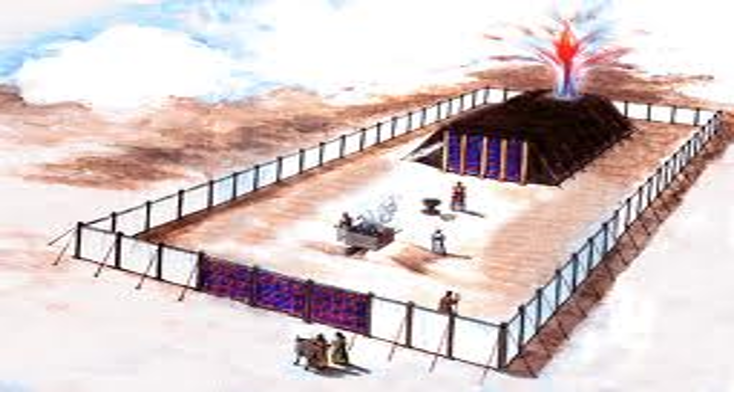
(1) The perimeter of the courtyard serves the function of separating this place of worship from the outside world. One enters into the courtyard for one purpose only and that is to draw near to God and to worship Him. How should this remind us of our attitude in attending our Sunday worship?
At this time, it is, perhaps, fitting for us to recollect and reflect on what we have read so far about the tabernacle:
(2) 25:1-9: God reveals His desire to “tabernacle” with His people beyond Mount Sinai.—How different is our God from all the gods of the pagans in this respect?
(3) 25:10-22: God shall reveal His presence and meet with Moses between the cherubim above the cover over the ark of the Testimony.—How does it reflect both God’s holiness and mercy?
(4) 25:23-30: A Table of Presence (face) shall be made with the Bread of Presence perpetually offered and maintained—How does this deepen our understanding of what Jesus, the Bread of Life, says of Himself, “I tell you the truth, unless you eat the flesh of the Son of Man and drink His blood, you have no life in you.” (Jn. 6:53)
(5) 25:31-40: A golden lampstand is to be made of pure gold to light up the Holy Place (27:20-21 mandates the use of clear oil and ensures its perpetual burning).—In what way should we become like Jesus, the light of this world, resembling the purity and brightness of the golden lampstand?
(6) 26:1-37 specifies the four-layered curtains and the separation of the Holy of Holies from the Holy Place.—Such a separation is no longer needed, as the barrier between the Most Holy God and sinners has once-for-all been torn down. Do you think the design of some churches or cathedrals which take after the pattern of the tabernacle, separating into three sections, is meaningful or biblical?
(7) 27:1-8 gives instruction for the building of the all-important altar without which there is no access to God.—How then shall we live as “living sacrifices” to God? (Rom. 12:1-2)
(8) 27:9-19: The building of the courtyard to separate the place of worship from the outside world.—What is the “real” world?—Is it within the courtyard or outside the courtyard?
(9) What is the main message for you today and how may you apply it in your life?
Meditative Reflection
A Real Courtyard
“Make a courtyard for the tabernacle...” (Exodus 27:9)
The need to construct a courtyard outside of the tabernacle proper is clearly to separate it and its activities from the world outside and rightfully so. In these days of life in the fast lane, for many Christians, Sunday worship within the sanctuary of God is the only time and place they can gain a moment of quietness and sanity (that is, if they could actually gain stillness within at all).
However, some church services are conducted like a variety show, with the constant loud noises of musical instruments and vocalists, that only serve to numb one’s inner feelings rather than make provision for true quietness for reflection. Worse, some so-called seeker’s services are so action-oriented that one simply does not get a sense of “holiness” that must be associated with the worship of the Almighty God. This, perhaps, explains why more and more Evangelical Christians are returning to churches with high liturgy.
The church must provide a “courtyard” to shield the worshippers from outside activities and distractions. It takes intentional planning of the worship that avoids too much chatting and socializing before the service, with carefully chosen hymns or songs which promote adoration, a biblical message that is Christ-centered and ample time for prayers and meditations. And may I be bold to suggest that, for Evangelical churches, they expand the time of the closing prayer which should be the climax of the whole worship, so that the worshippers might gather their thoughts for the entire service and respond, quietly and fully, to what the Spirit has spoken to them. Otherwise, once they step out of the “courtyard”, however wonderful a worship experience they might have had, whatever God has laid in their heart will dissipate over the brunch table.
Day 7
Scriptural Reflection
Exodus 28:1–9
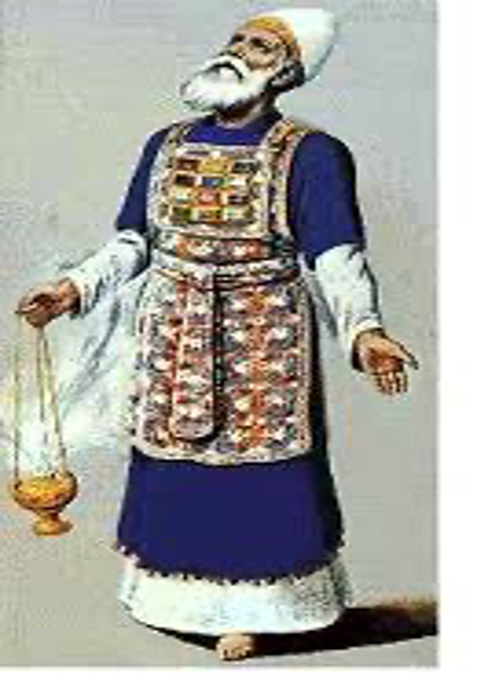
(1) What is the purpose of having to make special garments for the priest?
(2) What do the garments have to do with the priest’s consecration?
(3) What is the role of a priest?
(4) In the case of Aaron and his sons, their role is that of a high priest, and with that comes the sacred garments that include an ephod (perhaps like a vest), a breastpiece, a robe, a tunic, a turban and a sash. It is specified here that the skilled workers are to “use gold, and blue, purple and scarlet yarn, and fine linen.” What do the garments have in common with the materials of the tabernacle? What might the reason be?
(5) On the shoulder of the priest, two onyx stones are to be engraved with the names of the sons of Israel:
a. What is the purpose of having these names to be borne on their shoulders?
b. What is meant by “as a memorial before the Lord”?
c. Why should the names be engraved on precious stones?
(6) What is the main message for you today and how may you apply it in your life?
Meditative Reflection
Jesus the High Priest
“Therefore he is able to save completely those who come to God through him, because he always lives to intercede for them.” (Heb. 7:25)
To me, the most striking features of the garments of the high priest are the two onyx stones on his shoulder straps and the twelve stones of his breastpiece that bear the names of the twelve tribes of Israel.
This reminds the High Priest of his awesome responsibility before the Lord on behalf of the people in these ways:
- To stand before the Lord with the names on his shoulders, as a “memorial”—that is to remind God of His covenant with all His people.
- To bear in his breast, which is his heart, all the time, the twelve tribes of Israel.
This awesome responsibility is now assumed also by shepherds of the church. We are to put our people on our shoulders—the spiritual well-being, especially their eternal destiny, falls on our shoulders. It is a heavy responsibility. But we are not only to shoulder this responsibility, but to bear the people in our heart—to remember them all the time, especially in prayers. This, too, can be a heavy burden.
But if we think this is entirely our responsibility, then we are in error, because the true High Priest is our Lord Jesus Christ who “always lives to intercede for them.”
I have often come across church leaders and pastors with heavy hearts (and thus long faces) who seem to bear the burden of their people all by themselves. And when I have the privilege of praying with them, they plead with the Lord as if they are the only ones who care. The truth of the matter is: It is He who draws us to come before Him, to join Him in intercession. I am not sure that it is we who share His burden, or it is He who shares ours. I believe the former is true. It is He, the High Priest who bears all our names before the Father. It is He, the High Priest who bears all our names in His heart. To realize this is to experience that His yoke is easy and His burden is light, because He has borne the bulk of all these weights.